
|
|
PRINT » |
|
|
E-MAIL THIS PAGE » |
|
|
CLOSE THIS WINDOW » |
Feature Article from the July 2009 Magazine Issue
When the Smoke Cleared
California winemakers face tough pre-bottling decisions for 2008 wines
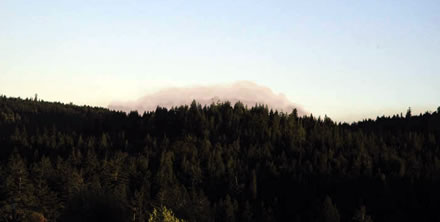
PHOTO:Larry Londer
He's not alone. Hundreds of other North Coast producers are re-examining the 2008 vintage before bottling. Those whose vineyards were affected by wildfire smoke face tough choices about processing and finishing those wines.
For Londer, the journey began June 22, 2008, the day after an electrical storm ignited 2,000 wildfires in 17 counties across Northern California. Having faced an unpredictable spring, Londer surveyed his vineyard from Highway 128 near Philo, wondering what other unforeseen challenges the 2008 harvest could possibly yield.
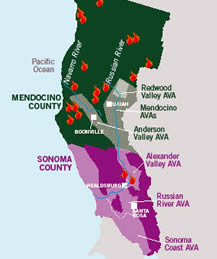
With wildfires burning near the towns of Boonville and Philo, a ribbon of smoke uncoiled across the Anderson Valley like an interminable, fire-breathing serpent. A layer of cool, dense marine air trapped smoke beneath the skyline and pushed the falling ash into Sonoma and Lake counties. (See Wines & Vines, January 2009).
"Last year, we experienced every plague except the locusts," he says. "Twenty-one freezing nights, little water, wind during flowering, a heat spike in May, wildfires in June and July, frost again during harvest and a heavy rain during crush.
"We've overcome every challenge except the smoke," he says.
For weeks after the Mendocino wildfires began, however, Londer thought more about his crew than the vines he hired them to tend. Recalling his days as a medical student caring for patients during a pulmonary rotation, he dispensed masks to his field crew.
"I was worried that the thick smoke that settled over the vineyard could affect them for years to come," he recalls.
Woodland smoke contains volatile compounds, including carbonyls, esters, organic acids and phenols. Combustion ruptures long phenolic chains into fragments that scientists from the Australian Wine Research Institute (AWRI) attribute to smoke--aromas and flavor that in small concentrations a sommelier might describe as gamey or spicy, as in a French Côte-Rôtie or Italian Taurasi, but which in greater concentrations taste like ashes and feel like sandpaper rubbing against the back of your throat.
Like an unmasked fieldworker, grapevines ingest smoke. The latest research from the Department of Agriculture and Food Western Australia suggests that vines absorb severed volatile compounds through the stomata of the leaves, storing them in the wood until ripening fruit triggers the plants to transport the aromatics to the epidermal layers of the grapes. (The term "taint" is often used for the smoke effect, but research for this article uncovered no indication that smoky wines present a health concern.)
Londer sent the field crew home after they worked four hours in the vineyard. Fully contained by July 19, the Mendocino wildfire charred 54,817 acres and affected most of the grapes grown in the Anderson and Ukiah valleys.
Anderson Valley fruit
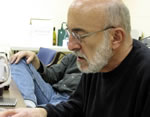
Winemaker Rick Davis, who managed Londer's 2008 vintage, admits that all the Pinot Noir and Chardonnay grapes that field hands harvested for the Mendocino County producer smelled like wood smoke or Lapsang Souchong tea.
Scientists attribute the smoky and spicy aromas and flavors in part to guaiacol (Gu) and 4-methyl guaiacol (4MGu), compounds they have identified in wines aged in toasted oak barrels. Both compounds take shape when heat decomposes lignin, an organic polymer present in all vascular plants.
"The Australians chose two markers (guaiacol and 4-methyl guaiacol) that are found in trace amounts or not normally present in wine that hasn't been exposed to toasted oak or smoke," explains Dr. Eric Hervé, a research chemist for ETS Laboratories in Napa.
ETS scientists measure minute concentrations of guaiacol and 4-methyl guaiacol with a gas chromatograph and mass spectrometer. The gas chromatograph separates the volatile compoun ds by passing the sample through a 30-foot column, and the mass spectrometer fractures each compound into a pattern that the spectrometer can identify and detect in concentrations less than one part-per-billion (ppb).
Sensing that something was wrong well before the grapes reached the sorting table, Davis consulted academic journals and other winemakers for answers. Todd Quigley, a seasoned winemaker who assisted Davis, anticipated the tainted harvest from the first day of summer and offered to help.
Davis and Quigley developed a method for reducing guaiacol and 4-methyl guaiacol by adjusting how workers at the winery pressed, fined and fermented tainted grapes.
For Chardonnay, they loaded the press with whole clusters of fruit, added PVPP (polyvinylpolypyrrolidone) and isinglass, pressed the juice into a settling tank, clarified it with additional fining agents, racked it clean, and then added yeast hulls to replace the suspended solids that the polymers and proteins had separated from solution.
"We sent samples to ETS (to measure guaiacol and 4-methyl guaiacol concentrations)," Londer says. "The results demonstrated that we do not have a problem with Chardonnay."
Davis and Quigley faced a daunting challenge with Pinot Noir, because the juice remains in contact with the skins during fermentation. Wine made from tainted Pinot Noir grapes can contain up to five times more guaiacol than the fruit.
For a varietal that continues to earn high marks for Londer from critics and colleagues alike, they added PVPP and isinglass during cold soak, reduced punchdowns and mixed untoasted oak flour with the fermenting juice of the most heavily tainted fruit.
Reducing smoke compounds
"Before fermentation," Quigley says, "we racked off the lees so that we could remove the bound phenols from solution. For the heavily fined juice, we added untoasted granular oak to boost tannins and pigment, because isinglass tends to strip it of anthocyanins."
While they reduced smoke compounds in four batches of Pinot Noir initially, the concentrations of guaiacol and 4-methyl guaiacol later returned to pre-fermentation levels for some lots of wine. According to research reported in the Journal of Agricultural and Food Chemistry, phenol concentrations can increase during malolactic fermentation, suggesting the presence of one or more precursor compounds.
Tasting smoke-affected wine
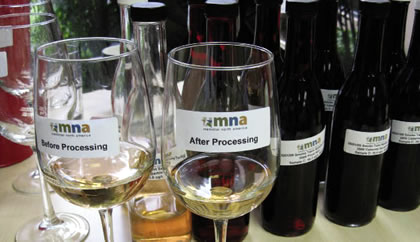
Concentrations of guaiacol (one of the primary smoke taint compounds) as low as 6 parts per billion were distinguishable in the "before" sample of an Anderson Valley Chardonnay as earthy aromas and an ash-like flavor and finish. The sensory threshold is believed to be 2 ppb. After processing, the wine showed no smoke, a touch of butter and light apple flavors. At the other extreme, a 2008 Merlot sample from the Willits area of Mendocino was measured at 220 parts per billion. The "before" sample had very strong, rubber-tire and burnt-rubber attributes from the aroma to the bitter, ash-like finish. The "after" version was firm, tannic, with modest fruit flavor but only slightly smoky. A sample of Pinot Noir from the Central Coast, with 15.5 ppb, had a slightly ashy aroma and smoky flavors before processing, along with appropriate varietal character, while in the "after" version the ash and smoke seemed to disappear and the fruit flavors turned fresh. An Alexander Valley Cabernet Sauvignon at 20.4 ppb had noticeable smoky character and very masked fruit "before," while the "after" version showed convincing fruit flavors, a juicy texture and lingering, pleasant finish. It was clear that processing helped the wines--significantly in some cases. Unclear to many winemakers was how such processed wines will evolve in sensory characteristics as they are blended, bottled and released. --Jim Gordon |
"We are unhappy with at least two of nine lots of Pinot Noir," Londer says.
Blending tainted with untainted wine to obscure the unwanted sensory properties is not a practical option. Scientists report that smoke's sensory imprint can persist after diluting 1 part of tainted with 50 parts of untainted wine. But data gleaned from the analysis of Londer's Pinot Noir, even with its seemingly contradictory results, points the way forward.
Three Pinot Noir clones grafted to the same rootstock, planted in adjacent vineyard blocks separated only by a change in elevation and ripening date, yielded three different concentrations of smoke compounds.
AWRI scientists evaluating the 2006-07 bushfires in northeast Victoria determined that concentrations of guaiacol and 4-methyl guaiacol are greater in fruit from vines growing in areas where smoke accumulates naturally.
Looking for answers, Londer sent samples of Pinot Noir to Mavrik North America (MNA) for filtration (see below).
"We reduced the taint by prefining," Londer admits, "but that lessened the effectiveness of filtering the wine."
Much like the weather, d eciphering the effect of the Mendocino wildfire on North Coast grapes is a complex task. According to Londer, "It's a question of geography and timing--the location of the vines and their stage of development when the smoke hits."
Good results
In spite of what he describes as his most difficult vintage, he is pleased with two or three of his Pinot Noir blends. "We plan to bottle one-quarter of the 5,500 cases that the winery produces in a typical year," Londer says.
The rest of the vintage will remain in storage tanks until he and his winemakers determine the next step for the 2008 vintage.
Ukiah Valley fruit
Fueled by wildfires that surrounded the Ukiah Valley, a haze covered the vineyards during the first five or six days of last summer. By the end of the week, so much smoke from so many directions gathered in the valley that the wind could not clear the air. Some vineyards sat in smoke for nearly five weeks.
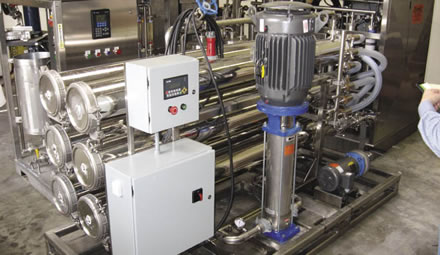
According to winemaker Bob Swain, the Bordeaux varieties and Pinot Noir were most susceptible to smoke damage from the wildfires. At first, the winery team experimented by fining the juice with milk and egg whites--without success.
So the winery team adopted a nanofiltration technique developed by scientists at MNA to separate water, alcohol and smoke compounds from everything else in the wine. As a second step in the technique, they relied on a tailored adsorbtive media to remove the smoke compound from the initial separation.
"I prefer nanofiltration to other filtering techniques, because the filter works at lower pressures," Swain says. Recognizing that free-run juice from whole bunch pressings contained less smoke than pressed fractions, team members separated free-run from hard-pressed juice.
"For Chardonnay and Sauvignon Blanc grapes, we separated the pressed fraction--approximately 15% of the juice--and fermented separately," Swain says.
For Cabernet Sauvignon, Merlot and Pinot Noir, the team filtered the complete pressing. "We've looked at the flavor profiles for each variety, and believe that we are removing the compounds that cause smoke taint," Dolan says.
Watching results unfold
Swain has already bottled the 2008 Sauvignon Blanc and Pinot Noir. Typically, he ages the Cabernet Sauvignon and Merlot in the barrel for as long as 18 months.
"We are very pleased with the results of the nanofiltration, but will be closely watching the wines as they mature," Swain says.
Bonterra Vineyards
Like Rick Davis and Todd Quigley, Bob Blue, winemaker for Bonterra Vineyards, faced the problem immediately. "Following the Australian protocol," Blue says, "we harvested at night to keep the white grapes cool and made an aggressive press cut. The result was that the free run was perfect, and the press fraction had the smoke flavors. There was nothing we could do on the red grapes, but fortunately a significant number of locations and varieties were not affected."
In a scene that played out at Bonterra shortly after fermentation of the white wines and after malolactic fermentation for the red wines, a cellarman pumped the pressed fraction for the white wine or the entire pressing of the red past a reverse osmosis filter.
Following a protocol developed by scientists at Winesecrets, a small portion of the liquid diffused through the membrane and then a carbon filter. The liquid recombined with the portion of wine that was left behind when it diffused through the membrane. The wine continued to circulate through the system, and Blue sampled it until he could not detect the smoke compounds. "It worked amazingly well," Blue says.
Well enough that his latest releases, the 2008 Mendocino Rosé and Sauvignon Blanc, have received excellent reviews.
Beyond Mendocino
Londer, Dolan and other Mendocino winemakers did not face the California wildfires alone. Eight of the state's 10 largest wildfires started during the summer's first thunderstorm. Parts of Trinity and Napa counties were ablaze by June 23, 2008. Smoke from the Anderson Valley and the Covelo fire funneled into Lake and Sonoma counties. The 163,000-acre Big Sur fire burned from June 21 until July 27, affecting vineyards in Monterey County. Fieldworkers harvested smoke-tainted grapes from Lake, Mendocino, Monterey, Napa, Sonoma and Trinity counties.
Bob Blue sums up the sentiments of many Northern California vintners who developed a plan, then tackled the smoke problem shortly after they harvested the fruit. "The wildfires were upsetting, and the smoke taint worrisome," Blue says, "but we handled it."
Smoke damage: 10 things to know
|
A regular contributor to Wines & Vines, Thomas Ulrich wrote "A Perfect Storm" for the January 2009 issue. Based in Silicon Valley, Ulrich has written news and feature stories for Time magazine, the Christian Science Monitor and the Washington Post. He teaches journalism at San Jose State University. Contact him through edit@winesandvines.com.
|
|
PRINT » |
|
|
E-MAIL THIS ARTICLE » |
|
|
CLOSE THIS WINDOW » |
